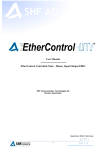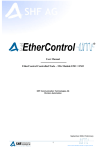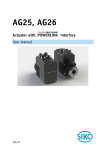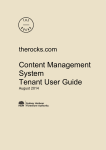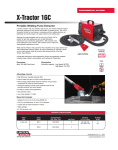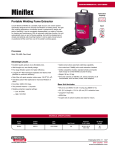Download User Manual EtherControl Controlled Node – Binary
Transcript
® User Manual EtherControl Controlled Node – Binary Output EBO SHF Communication Technologies AG Division Automation September 2006, Preliminary 1 SHFA-H-ETC-06CNBO1-003-EN --all rights reserved Content: 1. General information ...................................................................................................................... 3 Copyright ................................................................................................................................ 3 Intended use .......................................................................................................................... 3 Symbols / Abbreviations......................................................................................................... 3 2. System description ....................................................................................................................... 3 2.1. Ethernet Powerlink Networks ................................................................................................. 3 2.2. Controlled Node – EtherControl ............................................................................................. 5 2.3. Construction ........................................................................................................................... 5 2.4. Processor unit ........................................................................................................................ 5 2.5. Periphery unit ......................................................................................................................... 5 3. Technical data .............................................................................................................................. 6 3.1. Mechanical parameters.......................................................................................................... 6 3.1.1. General information ........................................................................................................... 6 3.1.2. Distance to the casing wall ................................................................................................ 6 3.1.3. Environmental Specification .............................................................................................. 6 3.1.4. Storage and transportation conditions ............................................................................... 7 3.1.5. Connectors......................................................................................................................... 7 3.2. Electrical parameters ............................................................................................................. 7 3.2.1. Supply of the module ......................................................................................................... 7 3.2.2. Protection........................................................................................................................... 7 3.2.3. Ethernet connection ........................................................................................................... 8 3.2.4. Binary outputs .................................................................................................................... 8 4. Installation..................................................................................................................................... 9 4.1. Mechanical setup ................................................................................................................... 9 4.2. Electrical installation............................................................................................................... 9 4.2.1. Connection of terminals A – D ........................................................................................... 9 4.2.2. Connection of power supply ............................................................................................ 10 4.2.3. Ethernet connectors......................................................................................................... 10 5. Controls ...................................................................................................................................... 10 5.1. Indicators.............................................................................................................................. 10 5.1.1. Display ............................................................................................................................. 10 5.1.2. Status indicators .............................................................................................................. 11 5.1.2.1. Error LED ................................................................................................................ 11 5.1.2.2. STATUS LED .......................................................................................................... 11 5.2. User elements ..................................................................................................................... 11 5.2.1. Address switches ............................................................................................................. 11 5.2.2. Control keys ..................................................................................................................... 11 5.2.3. Contrast level ................................................................................................................... 12 6. Technical description .................................................................................................................. 12 6.1. Module EBO ......................................................................................................................... 12 7. Menu selection............................................................................................................................ 13 7.1. Main menu............................................................................................................................ 13 7.2. Output simulation ................................................................................................................. 14 7.3. Changing of the IP address.................................................................................................. 15 7.4. Specification of module and Powerlink data ........................................................................ 16 7.5. Simulation enable................................................................................................................. 16 8. Object dictionary ......................................................................................................................... 17 8.1. Process data objects (PDO), Service data objects (SDO) and module parameters ........... 17 8.2. PDO Mapping....................................................................................................................... 19 8.3. NMT general objects ............................................................................................................ 20 8.4. Timing objects ...................................................................................................................... 21 8.5. Error signalling and handling................................................................................................ 21 8.6. Communication interface description error .......................................................................... 23 8.7. Others................................................................................................................................... 23 9. Accessories ................................................................................................................................ 24 9.1. 2-pin plug for the connection of voltage supply.................................................................... 24 9.2. 9-pin plug for the connection of the periphery (I/O connection)........................................... 24 9.3. Ethernet cable ...................................................................................................................... 24 1.1. 1.2. 1.3. 2 SHFA-H-ETC-06CNBO1-003-EN --all rights reserved 1. General information 1.1. Copyright This manual and the illustrations contained herein are provided by SHF AG and are copyright protected. Any reproduction, modification or translation into other languages without permission is an offence against copyrights and is forbidden. Violations will lead to compensation claims by SHF AG. (copyright according to DIN 34) 1.2. Intended use The devices are to be mounted and used only for the intended application. No express warranties and no implied warranties whether of merchantability or fitness for any particular use, or otherwise, other then those expressly set forth herein which are made expressly in lieu of all other warranties. Any usage or connection not described in this manual has to be coordinated with SHF AG and requires a written confirmation. Deviations between the product and the manual are possible. Make sure the version of the device is corresponding to the manual. Modifications without essential technical changes do not require any change in the manual. 1.3. Symbols / Abbreviations EPL BO MN CN HxWxD SpV GND STP Hex – – – – – – – – – Ethernet Powerlink Binary output Managing Node Controlled Node Height x Width x Depth Power supply input Ground Shielded twisted pair Hexadecimal 2. System description 2.1. Ethernet Powerlink Networks The physical base of the Ethernet Powerlink protocol is the normal Fast Ethernet 100Base-TX network. The difference of the Powerlink protocol is the combination of asynchronous and isochronous parts in a cycle. In the case of real time requirements in this real time part of the network, only Ethernet Powerlink units can be connected. To integrate other standard Ethernet devices it has to be used an Ethernet to Ethernet Powerlink gateway. The Ethernet Powerlink network requires one Managing Node (MN) to control the strictly deterministic data traffic. The cycle time is dependent on the number of the connected Controlled Nodes (CN) and the size of the asynchronous data part. With the smallest configuration (1 x MN and 1 x CN), a minimal cycle time 3 SHFA-H-ETC-06CNBO1-003-EN --all rights reserved of 200 µs can be achieved. The accuracy of the cycles (Jitter) will generally be 1 µs or lower. By using the asynchronous protocol part, the CN can be addressed from any browser through the connection of the Managing Node with the standard Ethernet. In that way by the continuous network structure remote control independent from the Ethernet Powerlink Protocol is possible. Direct access to the individual network units, for example via internet, will be available up to the Ethernet Powerlink network. If no real time functionality is required, the Ethernet Powerlink units can be used also in standard Ethernet networks. The topology of the Ethernet Powerlink network is very flexible. Depending on the technical specification of the CN, standard Ethernet Hubs or Switches, a star or daisy-chain topology or a mixture of both will be possible. Office Network Internet MN Hub CN CN Extension Module CN Extension Modules CN Internet Office Network CN Extension Module Powerlink Network Extension Network Example of an Ethernet Powerlink Network in connection to a super ordinate Ethernet Network. 4 SHFA-H-ETC-06CNBO1-003-EN --all rights reserved 2.2. Controlled Node – EtherControl The EtherControl module is a compact input and output device with own controller and storage area, as well as an Ethernet network connection. It consists of a processor and a peripheral unit. The module contains an integrated Hub. So it will be possible to create a daisy-chain topology without additional devices. Display 2.3. Construction Peripheral connectors A - B for screw or cage clamp plug-in Ethernet Connectors Address switches Serial interface Control Keys Peripheral connectors C - D for screw or cage clamp plug-in Power supply Construction of the EtherControl Module 2.4. Processor unit The processor unit of the EtherControl modules realises the I/O control, network connections, control of the display and the keys and running customised applications like compact PLC and data storage functions. On delivery the module is loaded with a basic program, running standard functions. The display shows basic information of the module as well as information about the inputs and outputs. The keys are used for navigation through the menu. Keys and display can be used also by customised software. On the module sockets for the network connection are present. Other hardware connections can be used with adapters connected to the RJ45 sockets. 2.5. Periphery unit The peripheral unit realises the connection to the process periphery. By the eight 9-pin plug can be connected up to 35 inputs and outputs. As standard applications are offered defined combinations of different binary and analogue inputs and outputs and in addition customized combinations are possible. 5 SHFA-H-ETC-06CNBO1-003-EN --all rights reserved 3. Technical data 3.1. Mechanical parameters 3.1.1. General information Dimensions H x W x D Housing material Mounting Installation orientation Weight 3.1.2. 131 x 151 x 58 mm ABS Clip mounting on DIN Rail Vertically or horizontally approx. 465 g without extension options Distance to the casing wall Right / Left Top / Bottom Front panel 0 mm 20 mm 40 mm Attention: The distance between the I/O modules and the casing walls must be kept to ensure sufficient ventilation. 3.1.3. Environmental Specification Ambient operating temperature Relative humidity Operating atmospheric pressure Pollution resistance 0 °C ... 50 °C (optio nally -20 °C ... +70 °C) 5 ... 95 %, non condensing 86 ... 108 hPa Test according IEC 60068-2-42 und IEC 60068-2-43 according IEC 60068-2-6 according IEC 60068-2-27 Additional measures have to be taken in the following environments: – dust, corrosive steams or gas – ionising radiation The product must not be used: – in medical applications – in life-supporting systems Vibrations Shocks Special conditions 6 SHFA-H-ETC-06CNBO1-003-EN --all rights reserved 3.1.4. Storage and transportation conditions Temperature Relative humidity Atmospheric pressure 3.1.5. -20 °C ... +70 °C (optional -30 °C ... +80 °C) 5 ... 95 %, non condensing 66 ... 108 hPa Connectors Power supply 2-pin plug – Screw- or cage clamp plug-in pluggable for wires up to 2,5 mm² 9-pin plug – Screw- or cage clamp plug-in pluggable for wires up to 2,5 mm² RJ45 plug RJ45 plug I/O plugs Ethernet connections Extension connections 3.2. Electrical parameters 3.2.1. Supply of the module Power supply Supply current (standard system) Power consumption 3.2.2. nominal 24V ( range 9-60V DC ) < 200 mA at 24 V DC (Modul without load) Max. 12 W Protection Protection class according EN 60 529 Conformation Reverse voltage protection Air/surface leakage distance IP 20 CE Yes According EN 61131-2 and EN 50178 between circuits and parts and isolated circuits, according overvoltage category II, degree of pollution 2 Yes, between digital part and inputs and outputs Test voltage DC 500 V Radiated and conducted according EN 55011 Isolation Electromagnetic emission 7 SHFA-H-ETC-06CNBO1-003-EN --all rights reserved 3.2.3. Ethernet connection Transmission hardware Transmission rate Interface connection CAT5 STP or better 10/100 Base-TX, 10/100 MBit RJ45 plug The three Ethernet connections are standard 10/100Base-TX interfaces for CAT5 or better twisted pair cables. Shielded twisted pair (STP) cabling is highly recommended. The Ethernet Powerlink specification requires use of cross-over cables but in addition standard patch cables can be used with the MN because of the build-in auto-detection of cable type. RJ45 jack RJ45 jack 1 2 3 4 5 6 7 8 1 2 3 4 5 6 7 8 Recommended Pin Assignment according Ethernet Powerlink specification 3.2.4. Binary outputs Output voltage Output current Output frequency Output delay Feedback Connection typical 24V (optionally 12-42V) ≤ 500 mA short-circuit proof ≤ 2 kHz 100 µs ± 50 % Short circuit and external power detection 2-wire connection with separate ground clip - separate output power supply together for each output group 32 ( 4 groups ever 8 outputs ) Outputs groups separated from each other and from the digital part Number of outputs Isolation Internal electronics 12 … 40 V 5 … 60 V on request Output Ground Output status Binary output schematic 8 SHFA-H-ETC-06CNBO1-003-EN --all rights reserved 4. Installation 4.1. Mechanical setup – – – The modules can be snapped directly onto a carrier rail in accordance with the European standard EN 50022 (DIN 35). The spacing between adjacent components, cable conduits, casing and frame sides must be maintained for the complete field bus node according paragraph 3.1.3. For disassembly use a screw driver for pulling down the mounting part. Assembly instructions: Assembly Disassembly 1. Slip over 2. Click in 2. Turn out 1. Disengage 4.2. Electrical installation 4.2.1. Connection of terminals A – D Top (a) 1 9 Bottom (b) 1 9 Connectors with nine contacts are used either with screw or cage clamp wire connection. Normally the modules are delivered with screw plug-in. 9 SHFA-H-ETC-06CNBO1-003-EN --all rights reserved 4.2.2. Connection of power supply + - Power supply will be connected with a bipolar plug with either screw or cage clamp wire connection. The connector can be locked with two screws. 4.2.3. Ethernet connectors In the modules there are two Ethernet sockets belonging to one Ethernet port. They are internally connected via a hub. The connection with the network is done with a RJ45 twisted pair connector. The network connection has to be done on port Eth 0. The indicator “Link” lights on network link, the indicator “Data” flashes on data packets. 5. Controls 5.1. Indicators 5.1.1. Display The modules have an alpha numerical display with two rows / sixteen columns. The display shows the actual process data as well as information’s about the module itself and the communication status, e.g. errors. The interaction with the module is done by menus shown on the display. It is possible to write to the display within customer specific software. 10 SHFA-H-ETC-06CNBO1-003-EN --all rights reserved 5.1.2. Status indicators 5.1.2.1. Error LED ERROR LED function is controlled by NMT State Machine transitions. LED OFF LED ON Power On, EPL cycles without errors (NMT_CT11) EPL cycles disturbed/aborted due to communication errors (NMT_CT3,_CT6) 5.1.2.2. STATUS LED STATUS LED (Ready) function is controlled by NMT State Machine states. LED off LED flickering LED single flash LED double flash LED triple flash LED on LED blinking NMT_GS_OFF NMT_GS_INITIALISING, NMT_CS_NOT_ACTIVE NMT_CS_BASIC_ETHERNET NMT_CS_PRE_OPERATIONAL_1 NMT_CS_PRE_OPERATIONAL_2 NMT_CS_READY_TO_OPERATE NMT_CS_OPERATIONAL NMT_CS_STOPPED 5.2. User elements 5.2.1. Address switches The both Hex-switches control the last byte of the IP address. If the module communicates via the Powerlink protocol, this hex switch also determines the module address in the real time network. 5.2.2. Control keys The keys are used to navigate through the build in menus. For the detailed explanation of the menus see module menu description. 11 SHFA-H-ETC-06CNBO1-003-EN --all rights reserved 5.2.3. Contrast level The contrast of the display can be adjusted with a little screw driver. 6. Technical description 6.1. Module EBO This module has 32 binary outputs. The supply voltage for the outputs is provided separately for the output blocks A – D via the clamp SpV. Port configuration: Aa (top) 1 2 3 4 5 6 7 8 9 SpV. A+ BO1 BO2 BO3 BO4 BO5 BO6 BO7 BO8 Ab (bottom) GND A GND A GND A GND A GND A GND A GND A GND A GND A Ba (top) SpV. B+ BO9 BO10 BO11 BO12 BO13 BO14 BO15 BO16 Bb (bottom) GND B GND B GND B GND B GND B GND B GND B GND B GND B Ca (top) SpV. C+ BO17 BO18 BO19 BO20 BO21 BO22 BO23 BO24 Cb (bottom) GND C GND C GND C GND C GND C GND C GND C GND C GND C Da (top) SpV. D+ BO25 BO26 BO27 BO28 BO29 BO30 BO31 BO32 Db (bottom) GND D GND D GND D GND D GND D GND D GND D GND D GND D 12 SHFA-H-ETC-06CNBO1-003-EN --all rights reserved 7. Menu selection After power on the display will show the actual status of the outputs as standard display for instance The selection can be made by the keys ESC ▲ , , 0010000100000000 0100000000000100 ▼ and ENTER . 7.1. Main menu With the arrow keys can be scrolled trough the menu and with the "ENTER" key the appropriate submenu can be selected. A return to the standard display is made by the "ESC" key. The following menu options can be selected from the main menu: ESC ▲ ▼ Back step to standard display 0000000000000000 0000000000000000 ▲ ▼ Simulate Outputs ▲ ENTER 7.3. Changing of the IP address ENTER 7.4. Specification of module and Powerlink data ▼ General–Simulat. Disable ▲ 7.2. Output simulation ▼ Status Powerlink ▲ ENTER ▼ Change IP. Curr: 192.168.100.0 ▲ Standard display ENTER 7.5. Simulation enable ▼ 13 SHFA-H-ETC-06CNBO1-003-EN --all rights reserved 7.2. Output simulation In this menu the binary outputs can be pre set for simulation. Only after release under menu point 7.5., the simulation will be activated. By operation of the arrow keys selected channel flashes in each case (blue figured) and can be changed over "ENTER". Simulated channels are inversely shown. With the "ESC" key it is possible to return to the main menu. The simulated values are stored. ESC Selection of the output channel ▲ Back step to the main menu ▼ Output simulated to 0 (Low) ENTER 0000000000000000 0000000000000000 ▲ 0000000000000000 0000000000000000 ▼ ENTER ENTER 0000000000000000 0000000000000000 ▼ ▲ ▼ 0 1000000000000000 0000000000000000 …….. .……. ▲ ENTER ENTER 0000000000000000 0000000000000000 ▲ Output simulated to 1 (High) ▼ 14 SHFA-H-ETC-06CNBO1-003-EN --all rights reserved 7.3. Changing of the IP address The IP address for Ethernet Powerlink networks is fixed on 192.168.100.XXX. The differentiation of the CN is made by the lowest address byte. This address part is specified individually by the adjustment of the Address switches ID1 and ID2 for each module. If the modules are used in other networks the three higher bytes can be adjusted by the menu option "Change IP...". The setting takes place byte by byte via increase or decrease of the address part value. By operation of the "ENTER" key selected channel flashes in each case (blue figured). It is to be noted that without key actuation after 10 seconds the choose values are rejected. Pressing the "ESC" key within the 10 s the new address will be stored. Subsequently, a restart of the software of the module takes place. If the lowest address byte was changed by the address switches, the new IP address will only be stored after the confirmation by pressing the "ESC" key and the following restart of the software. ESC IP ( r e j e c t : 1 0 s ) : 192. 168. 100. 000 Saving IP. . . ENTER ESC IP ( r e j e c t : 1 0 s ) : 192. 168. 100. 000 New IP saved Restart NOW ENTER ESC IP ( r e j e c t : 1 0 s ) : 192. 168. 100. 000 Back step to standard display New IP rejected ENTER Back step to the main menu 15 SHFA-H-ETC-06CNBO1-003-EN --all rights reserved 7.4. Specification of module and Powerlink data Depending on the selection, the type of the module with the implemented software version or cycle and error of Ethernet Powerlink protocol will be displayed. ▲ ▼ Typ: EBO Version: V0.12 ESC ▲ ▼ Cycle : 0ms Error: 0 ▲ Back step to the main menu ▼ 7.5. Simulation enable This item in the main menu controls the simulation of all outputs. The simulation will be enabled or disabled by the "ENTER" key. The main menu will not be left. With the arrow keys it can be scrolled further thru the main menu. General–Simulat. Disable ENTER General–Simulat. Enable 16 SHFA-H-ETC-06CNBO1-003-EN --all rights reserved 8. Object dictionary The object dictionary of the CN is accessible by SDO communication via the MN. Most objects are statically pre-defined by a configuration file stored on the CN. Objects can be changed dynamically by SDO communication from the MN or a modified file can be downloaded and the CN be restarted. 8.1. Process data objects (PDO), Service data objects (SDO) and module parameters General List of PDOs and parameter objects addressable via SDO – Manufacture specific: Size Access Default Description Index Subindex 2001h Output Overload 0 1 ro 1 number of entries (1-8) (1=head or single module, 2-8=extension module) 1-8 4 ro 0 Overload 0-31 (U32) 0=OK, 1=Overload 2002h binary I/O polarity 0 1 ro 1 number of entries (1-8) (1=head or single module, 2-8=extension module) 1-8 4 rw 0 Polarity 0-31 (U32) 0=True, 1=Inverted 2006h Output Error Mode 0 1 ro 1 number of entries (1-8) (1=head or single module, 2-8=extension module) 1-8 4 rw FFFF. Error Mode 0-31 (U32) FFFFh 0=keep output, 1= use error value (default) 2007h Output Error Value 0 1 ro 1 number of entries (1-8) (1=head or single module, 2-8=extension module) 1-8 4 rw 0 Error Value 0-31 (U32) 2200h binary Outputs 0 1 ro 1 number of entries (1-8) (1=head or single module, 2-8=extension module) 1-8 4 rw 0 Output 0-31 (U32) 0= Off (0V), 1= On (24V) 2320h binary Outputs external Read Back 0 1 ro 1 number of entries (1-8) (1=head or single module, 2-8=extension module) 1-8 4 ro 0 Outputs Real Value 0-31 (U32) 0= Off (0V), 1= On (24V) 17 SHFA-H-ETC-06CNBO1-003-EN --all rights reserved General List of PDOs and parameter objects addressable via SDO – Standard Device Profiles: Index Sub- Size Access Default Description index 6000h binary Outputs Readback 0= Off (0V), 1= On (24V) 0 1 ro 4 number of entries 1 1 ro Output 1-8 Readback 2 1 ro Output 9-16 Readback 3 1 ro Output 17-24 Readback 4 1 ro Output 25-32 Readback 6200h binary Outputs 0= Off (0V), 1= On (24V) 0 1 ro 4 number of entries 1 1 rw 0 Output 1-8 2 1 rw 0 Output 9-16 3 1 rw 0 Output 17-24 4 1 rw 0 Output 25-32 6202h binary Output Polarity 0=True, 1=Inverted 0 1 ro 4 number of entries 1 1 rw 0 Output 1-8 2 1 rw 0 Output 9-16 3 1 rw 0 Output 17-24 4 1 rw 0 Output 25-32 6206h binary Output Error Mode (0=keep output, 1= use error value) 0 1 ro 4 number of entries 1 1 rw FFh Output 1-8 2 1 rw FFh Output 9-16 3 1 rw FFh Output 17-24 4 1 rw FFh Output 25-32 6207h binary Output Error Value 0 1 ro 4 number of entries 1 1 rw 0 Output 1-8 2 1 rw 0 Output 9-16 3 1 rw 0 Output 17-24 4 1 rw 0 Output 25-32 6320h 4 rw 0 binary Outputs (U32) 6322h 4 rw 0 binary Outputs Polarity (U32) 0=True, 1=Inverted 6326h 4 rw FFFF. binary Error Mode (U32) FFFFh 6327h 4 rw 0 binary Error Value (U32) RPDO (Poll-Request): Object Sub- Value Index index 1400h 0 2 1 0 2 0 Description PDO_RxCommParam_00h_REC NumberOfEntries_U8 NodeID_U8 MappingVersion_U8 18 SHFA-H-ETC-06CNBO1-003-EN --all rights reserved Object Index 1600h Subindex Value 0 1 2 3 4 4 0008_0000_00_01_6200h 0008_0008_00_02_6200h 0008_0010_00_03_6200h 0008_0018_00_04_6200h TPDO (Poll-Response): Object Sub- Value Index index 1800h 0 2 1 0 2 0 Object Index 1A00h Description PDO_RxMappParam_00h_AU64 NumberOfEntries_U8 Output 1-8 Output 9-16 Output 17-24 Output 25-32 Description PDO_TxCommParam_00h_REC NumberOfEntries_U8 NodeID_U8 MappingVersion_U8 Subindex Value Description 0 1 2 3 4 4 0008_0000_00_01_6200h 0008_0008_00_02_6200h 0008_0010_00_03_6200h 0008_0018_00_04_6200h PDO_TxMappParam_00h_AU64 NumberOfEntries_U8 Output 1-8 Readback Output 9-16 Readback Output 17-24 Readback Output 25-32 Readback 8.2. PDO Mapping Rx PDO mapping (Poll-Request-Frame): Payload Object Subindex Size Description Offset Index 0 6200h 1 1 Outputs 1-8 1 6200h 2 1 Outputs 9-16 2 6200h 3 1 Outputs 17-24 3 6200h 4 1 Outputs 25-32 Tx PDO mapping (Poll-Response-Frame) : Payload Object Subindex Size Description Offset Index 0 6000h 1 1 Output readback 1-8 1 6000h 2 1 Output readback 9-16 2 6000h 3 1 Output readback 17-24 3 6000h 4 1 Output readback 25-32 19 SHFA-H-ETC-06CNBO1-003-EN --all rights reserved 8.3. NMT general objects Object Index 1000h: NMT_DeviceType_U32: 0002.0191h D31-24 D23-20 0 0 D19 D18 D17 D16 D15-0 0 0 0 1 (Analogue (Analogue (Digital (Digital Output) Input) Output) Input) Device Profile Number 401d = 191h Object Index 1008h: NMT_ManufactDevName_VS Manufacturer Device Name: “SHF AG ” Object Index 1009h: NMT_ManufactHwVers_VS Manufacturer Hardware Version: “0001” Object Index 100Ah: NMT_ManufactSwVers_VS Manufacturer Software Version: “ECIO V0.9a (EPL 0.94, 4NetOS 2.4)” Object Index 1018h: NMT_IdentityObject_REC Subindex 0 1 2 3 4 Access Size Value Description ro 1 4 Number of Entries ro 4 0EACh VendorId_U32 ro 4 11h ProductCode_U32 ro 4 1 RevisionNumber_U32 ro 4 x SerialNumber_U32 Object Index 1F82h: NMT_FeatureFlags_U32 (ro) Bit Value Description 0 1 isochronous 1 0 SDO by UDP/IP 2 1 SDO by ASnd 3 0 SDO by PDO 4 0 NMT Info Services 5 0 Extended NMT State Commands 6 1 Dynamic PDO Mapping 7 0 NMT Service by UDP/IP 8-31 0 reserved 0= not supported, 1= feature supported Object Index 1F83h: NMT_EPLVers_U8 (ro) EPL Version 2.0: 20h Object Index 1F8Ch: NMT_CurrNMTState_U8 (ro) returns the current state of the NMT state machine Object Index 1F9Eh: NMT_ResetCmd_U8 (rw) This may be used to initiate a reset to the CN. The following values are valid: Name NMTInvalidService NMTResetNode NMTResetConfiguration NMTResetCommunication Value FFh 28h 2Ah 29h Description returned when read Reset CN Reconfigure CN Reset Communication 20 SHFA-H-ETC-06CNBO1-003-EN --all rights reserved 8.4. Timing objects Object Index 1006h: NMT_CycleLen_U32 This value can be set to enable control of the cycle time by the CN. When the actual cycle time exceeds this value, the CN will signal an error. The default value is 0 meaning cycle time check is disabled. Object 1F98h: NMT_CycleTime_REC Subindex 0: NumberOfEntries = 9 Subindex 1: IsochrTxMaxPayload_U16 (ro) = 8 Subindex 2: IsochrRxMaxPayload_U16 (ro) = 4 Subindex 3: PResMaxLatency_U32 (ro) = 20000 max. response time in ns to a PReq frame Subindex 4: PReqActPayload_U16 (rw) = 4 Subindex 5: PResActPayload_U16 (rw) = 8 Subindex 6: ASndMaxLatency_U32 (ro) = 100000 max. response time in ns to a SoA frame Subindex 7: MultipleCycleCnt_U8 (rw) = 0 number of multiplexed cycles (0=no multiplexed cycles) Subindex 8: AsyncMTUSize_U16 (rw) = 282 max. asynchronous frame size for ASnd frames Subindex 9: Prescaler_U16 (rw) = 2 toggle rate of the PS bit in SoC frames 8.5. Error signalling and handling Object Index 1001h: ERR_ErrorRegister_U8 0= No Error 1= Error Bit Description 0 Generic Error 1 n/a, always 0 2 Supply Voltage failure 3 n/a, always 0 4 Communication Error 5 n/a, always 0 6 reserved, always 0 7 Output Overload 21 SHFA-H-ETC-06CNBO1-003-EN --all rights reserved Object Index 1003h: ERR_History_ADOM Subindex 0: num_entries_U8 (writing a ‘0’ will clear the error history) Subindex 1-254: HistoryEntry_DOM Error Handling Objects: The cumulative counters (...Cum_U32) are counting the total number of errors. The threshold counters (…Thr_U32) are incremented when an error occures and decremented with each correct cycle indicating the relation between erroneous and correct cycles. The threshold value can be set to trigger an action when the threshold counter reaches this value. Object Index 1C0Ah Subindex Size 0 1 2 3 1 4 4 4 0 1 2 3 1 4 4 4 0 1 2 3 1 4 4 4 0 1 2 3 1 4 4 4 0 1 2 3 1 4 4 4 1C0Bh 1C0Ch 1C0Dh 1C0Eh Name/Description DLL_CNCollision_REC Monitors the Collision errors NumberOfEntries_U8 = 3 DLL_CNCollisionCum_U32 DLL_CNCollisionThr_U32 DLL_CNCollisionThreshold_U32 When reached state is changed to NMT_GS_RESET_COMMUNICATION DLL_CNLossSoC_REC Monitors the Loss of SoC events NumberOfEntries_U8 = 3 DLL_CNLossSoCCum_U32 DLL_CNLossSoCThr_U32 DLL_CNLossSoCThreshold_U32 When reached state is changed to NMT_CS_PRE_OPERATIONAL_1 DLL_CNLossSoA_REC Monitors the Loss os SoA events NumberOfEntries_U8 = 3 DLL_CNLossSoACum_U32 DLL_CNLossSoAThr_U32 DLL_CNLossSoAThreshold_U32 When reached state is changed to NMT_CS_PRE_OPERATIONAL_1 DLL_CNLossPReq_REC Monitors the Loss of Poll-Request events NumberOfEntries_U8 = 3 DLL_CNLossPReqCum_U32 DLL_CNLossPReqThr_U32 DLL_CNLossPReqThreshold_U32 When reached state is changed to NMT_CS_PRE_OPERATIONAL_1 DLL_CNSoCJitter_REC Monitors the Jitter error (see object index 1C13h) NumberOfEntries_U8 = 3 DLL_CNSoCJitterCum_U32 DLL_CNSoCJitterThr_U32 DLL_CNSoCJitterThreshold_U32 When reached state is changed to NMT_CS_PRE_OPERATIONAL_1 22 SHFA-H-ETC-06CNBO1-003-EN --all rights reserved Object Index 1C0Fh Subindex Size 0 1 2 3 1 4 4 4 0 1 1 4 4 1C10h 1C13h Name/Description DLL_CNCRCError_REC Monitors CRC errors NumberOfEntries_U8 = 3 DLL_CNCRCErrorCum_U32 DLL_CNCRCErrorThr_U32 DLL_CNCRCErrorThreshold_U32 When reached state is changed to NMT_CS_PRE_OPERATIONAL_1 DLL_CNLossOfLink_REC Monitors Loss of Link errors NumberOfEntries_U8 = 1 DLL_CNLossOfLink Cum_U32 DLL_CNSoCJitterRange_U32 (ns) defines the jitter for SoC cycles 8.6. Communication interface description error Object Index 1030h: NMT_InterfaceGroup_0h_REC Object Index 1031h: NMT_InterfaceGroup_1h_REC Subindex 0: Number of Entries = 9 Subindex 1: InterfaceIndex_U16 (ro) = 1 Subindex 2: InterfaceDescription_VS (ro) = “HyNet32XS_EthCtrl” Subindex 3: InterfaceType_U8 (ro) = 6 (ethernet csmacd) Subindex 4: InterfaceMTU_U32 (ro) = 1500 Subindex 5: InterfacePhysAddress_OSTR (ro) = MAC Address Subindex 6: InterfaceName_VS (rw) = “eth0” Subindex 7: InterfaceOperStatus_U8 (ro) = 0: Down, 1: Up Subindex 8: InterfaceAdminState_U8 (rw) = 0: Down, 1: Up Subindex 9: Valid_BOOL (rw) = TRUE Object Index 1032h – 1039h: NMT_InterfaceGroup_xh_REC Subindex 9: Valid_BOOL (rw) = FALSE Object Index 1F93h: NMT_EPLNodeId_REC Subindex 0: Number of Entries = 2 Subindex 1: NodeId_U8 (ro), set by Hex-Switch Subindex 2: NodeIdByHW_BOOL (ro) = TRUE 8.7. Others Object Index 1F99h: NMT_CnStateMachineTimeouts_REC Subindex 0: NumberOfEntries = 1 Subindex 1: BasicEthernetTimeout_U32 Timeout in µs before changing from NMT_CS_NOT_ACTIVE into NMT_CS_BASIC_ETHERNET state. Object Index 1F50h: PDL_DownloadProgData_ADOM Subindex 0: Number of programs (currently only 1 is supported, the default program) Subindex 1: Default Program (Firmware) 23 SHFA-H-ETC-06CNBO1-003-EN --all rights reserved Object Index 1F51h: PDL_ProgCtrl_AU8 Subindex 0: Number of entries (currently only 1 is supported, the default program) Subindex 1: Program Control: Read Access Value Write Access 0 Stop program (n/a) program stopped 1 Start program program running 2 Reset program program stopped Currently a read access will always return ‘1’ and a write of ‘1’ or ‘2’ will initiate a reset and restart of the CN. This is needed to start a new downloaded firmware (Program 1). Object Index 1F52h: PDL_LocVerApplSw_REC Version of the Default Program. Subindex 0: Number of entries (=2) Subindex 1: ApplSwDate_U32: Number of days since 1/1/1984 Subindex 2: ApplSwTime_U32: ms since midnight 9. Accessories As accessories the following materials will be offered: 9.1. 2-pin plug for the connection of voltage supply – – screw plug-in cage clamp plug-in 9.2. 9-pin plug for the connection of the periphery (I/O connection) – – screw plug-in cage clamp plug-in 9.3. Ethernet cable CAT 5 STP (shielded twisted pair), standard length of 2m. Cable of other lengths is available on inquiry. SHF Communication Technologies AG • Division Automation Wilhelm-von-Siemens-Str. 23 E • D - 12277 Berlin +49 30 772 051 19 • +49 30 7702 9848 • [email protected] • www.shf.de 24 SHFA-H-ETC-06CNBO1-003-EN --all rights reserved
























